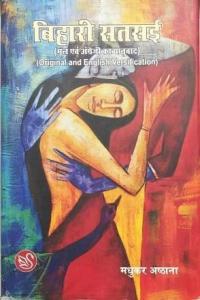Creation and Criticism
ISSN: 2455-9687
(A Quarterly International Peer-reviewed Refereed e-Journal
Devoted to English Language and Literature)
Vol. 06, Joint Issue 20 & 21: Jan-April 2021

Book Review
Bihari Satsai (Original and English Versification) by Madhukar Asthana
Madhukar Asthana, Trans., Bihari Satsai — Original and English Versification (Translation of Hindi Couplets into English). New Delhi: Shwetwarna Prakashan, 2020. Pp. 187. Price : Rs. 399/- (Hardcover). ISBN 978-81-9444559-09-2
Reviewed by Abnish Singh Chauhan
A new literary trend in poetry, which emerged around 1700 AD, is most frequently discussed in Hindi literature due to its explicit presentation of fervent love and aesthetic pleasures. The trend, which was primarily encouraged by the court culture as well as by the elite of that period, broadly uses the word— 'Riti' or 'Kavyariti' for poetry, keeping in mind inquisitive temperament, imaginative perception and creative inclination of the poet and the poetic texts representing ‘Rasa’, “a concept in Indian arts about the aesthetic flavor of any visual, literary or musical work that evokes an emotion or feeling in the reader or audience but cannot be described” (Encyclopedia Britannica, 2013).
Since most of the poets of ‘Riti Kaal’ (1650-1850) were courtiers— Keshavdas (Orchha), Pratap Singh (Charkhari), Bihari (Jaipur, Amer), Matiram (Bundi), Bhushan (Panna), Chintamani (Nagpur), Dev (Pihani), Bhikharidas (Pratapgarh-Awadh), Raghunath (Kashi), Beni (Kishangarh), Gang (Delhi), Tikaram (Baroda), Gwal (Punjab), Chandrashekhar Bajpai (Patiala), Harnam (Kapurthala), Newaz (Panna), Surti Mishra (Delhi), Kavindra Udayanath (Amethi), Rishinath (Kashi), Ratan Kavi (Srinagar-Garhwal), Beni Bandijan (Awadh), Beni Praveen (Lucknow), Brahmadutt (Kashi), Thakur Bundelkhandi (Jaitpur), Bodha (Panna), Guman Mishra (Pihani) etc., they wrote ornamental and artistic poetry mostly for the amusement of the kings and the noblemen. However, in terms of quality and quantity, the poetic literature of this time is praiseworthy for its passionate expressions of love and beauty, particularly in the portrayal of dignified and elegant appearance and concomitant charm of Lord Krishna and Radha— two highly respected and admired divine beings in the Hindu Vaishnavite tradition, along with the fabulous depiction of some unidentified beautiful women of Indian territory.
In spite of a long list of poets writing on the above mentioned themes of universal attention, Bihari Lal (1595-1663) is the best among them. Being a poet of high caliber, he is unsurpassed in the depiction of beautiful and expressive images created through communicative and touching words of poesy. He is also unparalleled in the composition of his poetry book— Satsai (1662), which is in the form of beautiful rhyming couplets in a Western Hindi language named as Brij Bhasha or Braj Boli. The Satsai, which was composed four and a half centuries ago, is still useful in the present scenario and, therefore, its splendid couplets demand a wider audience at the international level. Hence, these rhyming couplets are pleasantly translated from Hindi into English under the title— Bihari Satsai (Original and English Versification) by Madhukar Asthana, a Hindi poet from Lucknow, U.P.
The book contains a preamble to the life and works of Bihari in English along with a descriptive note in Hindi on his contribution to Hindi literature. After that a list of Hindi couplets in alphabetical order is followed by seven Shataka (century) having 721 couplets in each language— Hindi and English. The first Shataka begins with a request to ‘Radha’: “Rid me, Radha, of mundane ills/ whose shadow Krishna’s heart with joy fills” (37) and the last Shataka of the book ends with a note of gratitude to Lord Krishna and his beloved Radha as well as to Jai Singh, the then king of Jaipur/Amer: “At the order of Jai Singh and by Radha’s and Krishna’s grace,/ Bihari completed the Satsai in which all sentiments find place” (187). Since the Satsai comprises various shades of love, beauty and grandeur of ordinary people as well as extra-ordinary or divine persona of ‘Radha’ and ‘Krishna’, it expresses exquisite aspects of their lives without violating the rules of decorum and decency.
The Hindi part of the book is absolutely marvelous; but, sometimes a lack of clarity in the translation confuses the point being made through the use of vocabulary and sentence patterns in English. However, Bihari’s rhyming couplets dexterously reflect a lively sketch of Nature, specific personality traits of the loved ones, aesthetic sensitivity of the poet, uniformity of words and ideas and spectacular figures of speech used to create attraction and elucidation. Perhaps these are the everlasting qualities—indicative of the rhyming couplets of Bihari— that make Bihari Satsai worth reading.
About the Reviewer:
 Dr Abnish Singh Chauhan (1979), the editor of two online journals– Creation and Criticism and IJHER and a Hindi magazine– Poorvabhas, is presently serving as Professor and Principal, BIU College of Humanities & Journalism, Bareilly International University, Bareilly, U.P.. He has authored a number of books including Swami Vivekananda: Select Speeches, Speeches of Swami Vivekananda and Subhash Chandra Bose: A Comparative Study, The Fictional World of Arun Joshi: Paradigm Shift in Values and Tukda Kagaz Ka (A collection of Hindi Lyrics). He can be contacted at abnishsinghchauhan@gmail.com.
Dr Abnish Singh Chauhan (1979), the editor of two online journals– Creation and Criticism and IJHER and a Hindi magazine– Poorvabhas, is presently serving as Professor and Principal, BIU College of Humanities & Journalism, Bareilly International University, Bareilly, U.P.. He has authored a number of books including Swami Vivekananda: Select Speeches, Speeches of Swami Vivekananda and Subhash Chandra Bose: A Comparative Study, The Fictional World of Arun Joshi: Paradigm Shift in Values and Tukda Kagaz Ka (A collection of Hindi Lyrics). He can be contacted at abnishsinghchauhan@gmail.com.


